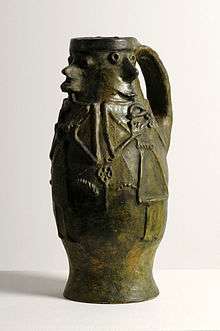Face jug

A face jug is a jug pottery that depicts a face. Early examples date from the 14th century.[1] Some of the best known vessels come from North Carolina, South Carolina and Georgia, made by African-American slaves in the mid-1800s. Though the jugs' exact purposes are unknown, many scholars believe they have either practical or spiritual value. Other names associated with African-American face jugs are grotesque jars, monkey jars, or face jars.[2] Modern interpretations started appearing in the same regions during the 1940s.[3]
The Coventry Herbert Art Gallery and Museum exhibits a rare medieval face jug unearthed beside the site of the local Benedictine priory.[1]
Early forms
England
During the 13th century, craftsmen outside of London became more decorative in their style, creating more anthropomorphic vessels that would characterize Medieval face jugs.[4] In the 1600s full body vessels supposedly modeled after Edward Vernon also known as Admiral Vernon. These pieces came to be known as British Toby Jars.[5]
Africa
African Nkisi dolls, native to the Congo, were considered both object and human. These dolls were made with many different materials including clay. They came to America transported through slave trade, and are found more commonly in Latin American regions. The vessels are full figured pieces characterized by the same exaggerated human features often seen on African-American face jugs. Many rituals associated with Nkisi dolls are used either to aid or to harm a person or other living creature that the dolls play a stand-in role for, or as an extension of a spiritual leader, or as a being that stores spiritual energy.[6]
Speculated uses
Face jugs were fully functional pieces that served the practical purpose of holding and pouring liquid. Various slave owner accounts hold that African-American slaves would use their face jugs to carry water into the fields with them.[7] Other scholars believe that face jugs were used as a form of self-identification, or a Self-Portrait and perhaps were a way for slaves to deal with their physical displacement and loss of visual worth.[8] Some folklore accounts held that these jugs were used for spiritual, rather than practical, purposes. It is believed that the jugs were buried outside of front and back doors to scare spirits away. It is also claimed that these jugs were used as grave markers and placed atop burial sites surrounded with the possessions of the deceased.[7]
Artistic value
As Folk art, face jugs have become a significant feature in the history of African-American art. Because formal ceramic skills to create face jugs were taught after America gained its independence, they are regarded as some of the first truly American pieces.[9] Because of their interesting physical characteristics and historical context behind them, face jugs are important examples of African-American art and as the start of a theme of self-identification that would carry into the future.[10] Some use these vessels may have been as political symbols. Most famously, it is believed that Dave the Potter, a slave who worked in the Miles mill where face jugs were made, was himself protesting against his status through ceramic pieces.
Exhibits
- 13 July 2000 Massachusetts.[11]
List of American makers of face jugs
American art potters who create face jugs include:
- Clint Alderman (1981-)Demorest Ga.[12]
- Ronnie Payne, Emerson, Georgia (http://www.paynepottery.com)
- Burlon Craig (1914-2002) and
- Robert A. Crook
- Jerry Dolyn Brown
- Max Freedman
- Charles Lisk from the Catawba Valley Pottery
- Lanier Meaders (1917-1998)
- William A. Flowers
- Rob Withrow of Smoke in the Mountains Pottery and John C. Campbell Folk School, Brasstown, North Carolina
- Jason Mahlke
- Clayton Bailey [13]
- Skip Staabe of Sautee Nacoochee, GA
- Terry King of Seagrove NC www.kingspottery.com /
- Larry Moore[14] of Seagrove NC
See also
| Wikimedia Commons has media related to Face jugs. |
References
- 1 2 Goulden, Barbara. THE HERBERT REVEALS ALL Coventry Telegraph 30 October 2008
- ↑ "Encyclopedia Smithsonian: American Face Vessels." Accessed 13 September 2014. http://www.si.edu/Encyclopedia_SI/nmah/facevess.htm.
- ↑ Ketchum, William C. (2003). "JUGS, FACE". The Encyclopedia of American Folk Art. Cynthia Parzych Publishing, Inc.
- ↑ Spencer, Brian. "Medieval Face-Jug (The London Museum)." The Burlington Magazine 111, no. 794 (1 May 1969): 303–302.
- ↑ N., J. G. "Old English Pottery." The Burlington Magazine for Connoisseurs 58, no. 335 (1 February 1931): 98.
- ↑ Young, Jason R. Rituals of Resistance: African Atlantic Religion in Kongo and the Lowcountry South in the Era of Slavery. LSU Press, 2011.
- 1 2 Watch Now: History Detectives | Face Jug. Accessed 10 September 2014. http://video.pbs.org//video/1918318256/.
- ↑ Hall, James. The Self-Portrait: A Cultural History. Thames & Hudson, 2014.
- ↑ Patton, Sharon F. African-American Art. Oxford University Press, Incorporated, 1998.
- ↑ Dover, Cedric. American Negro Art. New York Graphic Society, 1967.
- ↑ "The Item - Google News Archive Search." Accessed 10 September 2014. https://news.google.com/newspapers?id=CokiAAAAIBAJ&sjid=g60FAAAAIBAJ&pg=5101%2C2925679.
- ↑ Burrison, John A. From Mud to Jug, University of Georgia Press
- ↑ http://www.claytonbailey.com/jugheads.htm
- ↑ "Larry Moore Face Jug Southern Folk Pottery Seagrove NC (12/03/2006)". Worthpoint. Retrieved 2016-06-27.
External links
- Selections of nineteenth-century Afro-American Art, an exhibition catalog from The Metropolitan Museum of Art (fully available online as PDF), which contains material on face jugs